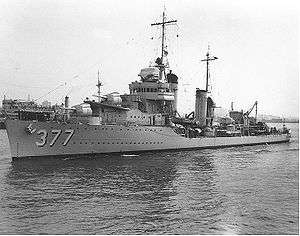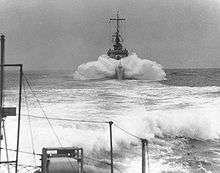USS Perkins (DD-377)
The second USS Perkins (DD–377) was a Mahan-class destroyer in the United States Navy before and during World War II. She was named for George Hamilton Perkins.
 | |
| History | |
|---|---|
| Namesake: | George Hamilton Perkins |
| Builder: | Puget Sound Navy Yard |
| Laid down: | 15 November 1934 |
| Launched: | 31 December 1935 |
| Commissioned: | 18 September 1936 |
| Fate: | Accidentally rammed and sunk by Australian troopship Duntroon, 29 November 1943 |
| General characteristics | |
| Class and type: | Mahan-class destroyer |
| Displacement: | 1,500 tons |
| Length: | 341 ft 4 in (104.04 m) |
| Beam: | 35 ft (11 m) |
| Draft: | 9 ft 10 in (3.00 m) |
| Speed: | 37 kn (69 km/h) |
| Complement: | 158 officers and crew |
| Armament: |
|
Perkins was laid down 15 November 1934 at the Puget Sound Navy Yard, Bremerton, Washington. She was launched 31 December 1935, sponsored by Mrs. Larz Anderson, commissioned 18 September 1936, with Lieutenant Commander Samuel P. Jenkins in command.
Operational history
Assigned first to Destroyers, Scouting Force then to Destroyers, Battle Force, Perkins was homeported at San Diego, California and operated in the eastern Pacific prior to World War II. At Mare Island Naval Shipyard for overhaul, 7 December 1941, she reported for convoy escort duty on the 15th and on the 17th was en route to Pearl Harbor. By 15 January 1942 she was back at Mare Island for the installation of new radar equipment and on the 25th she returned to Hawaii.
On 2 February she departed Pearl Harbor with Chicago, for the southwest Pacific. On the 14th she joined Australian, New Zealand and other U.S. ships in the ANZAC Squadron then charged with protecting the eastern approaches to Australia and New Zealand. Through the spring, she continued operations with that squadron, steaming at times with fast carrier forces as they plied the Coral Sea to strike at enemy encroachments, escorting refueling units to rendezvous areas, and screening larger ships of her own and combined forces as they blasted enemy positions from New Guinea to the Solomon Islands.

On 1–2 May, the squadron joined with TF 11 and TF 17, then screened the carriers of those forces as their planes struck at Tulagi to open the Battle of the Coral Sea. Detached on the 7th, the squadron steamed to the Louisiade Archipelago to intercept a Japanese amphibious attack on Port Moresby via the Jomard Passage. That afternoon the ships were attacked by land-based planes, and in driving them off contributed to the diverting of the Japanese force, thus accomplishing the mission without engaging the enemy ships and setting the stage for the final action of the Battle of the Coral Sea—the carrier battle on 8 May.
As the carrier forces fought to a draw, the ANZAC squadron continued to patrol to the southeast of Papua. On the 10th the squadron headed for Australia and for almost two months Perkins escorted convoys and patrolled off harbor entrances along that country's Coral and Tasman Sea coasts. During this time, Perkins was one of several major Allied vessels in Sydney Harbour during the Japanese midget submarine attack of 31 May 1942.[1]
On 11 July she sailed for Auckland, thence to Noumea. Convoy escort duty between Suva and New Caledonia followed and in mid-August she was forced back to New Zealand for propeller repairs. On the 20th, however, she sailed for Pearl Harbor where repairs were completed and additional radar equipment and 40 mm guns were installed.
In mid-November Perkins headed west again, arriving at Espiritu Santo on the 27th. Three days later she departed Segond Channel in Rear Admiral Carleton Wright's cruiser-destroyer force to intercept and destroy enemy forces attempting to reinforce their units on Guadalcanal. At 2315, five radar contacts were made and a few minutes later the Battle of Tassafaronga was engaged. Perkins loosed eight torpedoes, scoring none, then turned her guns on the beach. Undamaged in the encounter she turned toward Tulagi to assist the burning Pensacola, while Maury went to assist New Orleans. Continuing operations from Tulagi, she bombarded the Guadalcanal coast and served on escort assignments until January 1943. A brief availability at Noumea followed and by the 13th she was back at Tulagi for further escort and support missions.
At the end of April Perkins joined TF 10 for tactical training and in May she returned to Australia to join the forces gathering for the thrust up the New Guinea coast to gain control of the Huon Peninsula. Into the summer the base at Milne Bay grew. At the end of June, Allied amphibious forces moved into Nassau Bay, just south of Salamaua, and into the Trobriands. Infantry units pressed toward Salamaua-Australians from Wau in the foothills of the Owen Stanley Range and Americans from Nassau Bay. PT boats punched at the enemy's Finschhafen-Lae supply line and AAF and RAAF planes bombed and strafed Japanese installations as far as Wewak and Madang.
On 21 August Perkins, flagship of DesRon 5, led Smith, Conyngham, and Mahan out of Milne Bay to make a sweep of Huon Gulf then bombard Finschhafen. On the night of 22–23 August they accomplished their mission and brought naval gunfire back to the New Guinea campaign after its absence through 18 months of ground fighting.
On 4 September Perkins bombarded the coast between the Bulu and Buso rivers, then covered Allied soldiers as they streamed ashore at Red Beach and headed toward Lae. On the 8th, she trained her guns on the isolated garrison at Lae and on the 15th the last remnants of that garrison pulled out. Salamaua, dependent on Lae, had already fallen and on the 16th Allied forces marched into Lae.
Fate
Finschhafen fell 2 October, the scouring of the river valleys commenced, and the increase in Allied traffic in Huon Gulf, together with the presence of Japanese submarines, brought Perkins back to escort duty. Reinforcements were escorted to Langemak Bay and to Scarlet Beach east of Satelberg. In November escort duties continued. Then, on 28 November 1943, she departed Milne Bay for Buna, steaming independently. Shortly before 0200 on the 29th a dark image emerged from the blackness and a few minutes later the Australian troopship Duntroon rammed her on the portside, amidships. Splitting in two, Perkins went down approximately 2 miles off Ipoteto Island. Nine personnel were killed, and a tenth seriously injured.[2] A court of inquiry, held in San Francisco the following month, later held the captain of Perkins accountable for the incident, along with his executive officer and officer-of-the-deck.[2]
Honors
Perkins earned 4 battle stars during World War II.
See also
- List of United States Navy destroyers
References
- Jenkins, David (1992). Battle Surface! Japan's Submarine War Against Australia 1942–44. Milsons Point: Random House Australia. pp. 193–194. ISBN 0-09-182638-1.
- Howarth, Ross (May 1999). "Motor Vessel Duntroon" (PDF). The Duntroon Society (1/1999): 1–2. Archived from the original (PDF) on 2013-11-08.
- This article incorporates text from the public domain Dictionary of American Naval Fighting Ships. The entry can be found here.